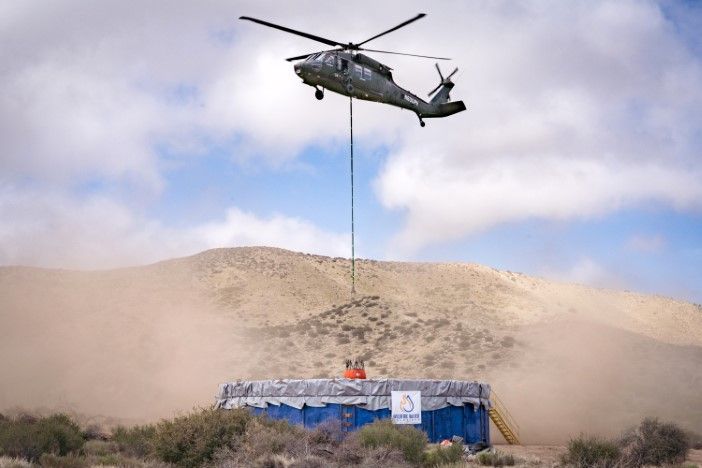Testing Autonomous Flight: Black Hawk Helicopter's Potential In Wildfire Suppression

Welcome to your ultimate source for breaking news, trending updates, and in-depth stories from around the world. Whether it's politics, technology, entertainment, sports, or lifestyle, we bring you real-time updates that keep you informed and ahead of the curve.
Our team works tirelessly to ensure you never miss a moment. From the latest developments in global events to the most talked-about topics on social media, our news platform is designed to deliver accurate and timely information, all in one place.
Stay in the know and join thousands of readers who trust us for reliable, up-to-date content. Explore our expertly curated articles and dive deeper into the stories that matter to you. Visit Best Website now and be part of the conversation. Don't miss out on the headlines that shape our world!
Table of Contents
Testing Autonomous Flight: Black Hawk Helicopter's Potential in Wildfire Suppression
Wildfires are devastating natural disasters, causing billions of dollars in damage and tragically claiming lives each year. Current wildfire suppression methods, while effective in some situations, are often hampered by dangerous conditions and limited accessibility. This is where autonomous flight technology, specifically applied to versatile aircraft like the Black Hawk helicopter, presents a game-changing opportunity. Recent tests are showcasing the immense potential of autonomous Black Hawks in revolutionizing wildfire response.
The Challenge of Wildfire Suppression:
Fighting wildfires is a dangerous and complex undertaking. Ground crews face extreme heat, unpredictable flames, and hazardous terrain. Air support, while crucial, often relies on pilots working in perilous conditions, leading to fatigue and increased risk. The need for a safer, more efficient, and readily available aerial solution is paramount.
Autonomous Black Hawks: A Technological Leap Forward:
The integration of autonomous flight systems into Black Hawk helicopters offers a groundbreaking solution. These systems, incorporating advanced sensors, AI-powered navigation, and sophisticated flight control algorithms, enable the helicopter to operate independently, carrying out tasks such as:
- Precise Water Dropping: Autonomous systems can accurately target water drops, maximizing efficiency and minimizing water waste. This precision is crucial in controlling the spread of flames in sensitive areas.
- Real-Time Data Acquisition: Equipped with thermal imaging and other advanced sensors, autonomous Black Hawks can gather real-time data on fire behavior, providing crucial information to ground crews and strategic command.
- Extended Operational Capabilities: Autonomous operation allows for extended flight times, as pilot fatigue is no longer a limiting factor. This means greater coverage and sustained suppression efforts.
- Reduced Risk to Human Pilots: By removing human pilots from the most hazardous aspects of wildfire fighting, autonomous systems significantly reduce the risk of injury or fatality.
Recent Testing and Future Prospects:
While the technology is still under development, recent tests have yielded promising results. [Insert link to a relevant news article or research paper detailing the tests]. These trials have focused on the reliability and accuracy of autonomous navigation and water-dropping capabilities in simulated wildfire environments. The next steps involve refining the technology, conducting more extensive field tests, and addressing regulatory hurdles.
Beyond Wildfire Suppression:
The applications of autonomous Black Hawk technology extend beyond wildfire suppression. This technology holds immense potential for:
- Search and Rescue Operations: Autonomous helicopters could navigate challenging terrain to locate and assist individuals in need.
- Disaster Relief: These systems could deliver vital supplies and personnel to disaster-stricken areas inaccessible by conventional means.
- Infrastructure Inspection: Autonomous flight allows for efficient and safe inspection of power lines, bridges, and other critical infrastructure.
The Road Ahead:
While challenges remain, the potential benefits of autonomous Black Hawk helicopters in wildfire suppression and other critical applications are undeniable. Further investment in research and development, coupled with robust regulatory frameworks, will be crucial in realizing the full potential of this transformative technology. The future of disaster response and resource management may well lie in the skies, autonomously piloted by sophisticated AI systems.
Call to Action: Learn more about the ongoing research and development efforts in autonomous flight technology by visiting [link to a relevant organization or website]. Stay informed about the latest advancements in this rapidly evolving field.

Thank you for visiting our website, your trusted source for the latest updates and in-depth coverage on Testing Autonomous Flight: Black Hawk Helicopter's Potential In Wildfire Suppression. We're committed to keeping you informed with timely and accurate information to meet your curiosity and needs.
If you have any questions, suggestions, or feedback, we'd love to hear from you. Your insights are valuable to us and help us improve to serve you better. Feel free to reach out through our contact page.
Don't forget to bookmark our website and check back regularly for the latest headlines and trending topics. See you next time, and thank you for being part of our growing community!
Featured Posts
-
 Rockets First Round Exit Fuels Promise Of A Stronger Return
May 08, 2025
Rockets First Round Exit Fuels Promise Of A Stronger Return
May 08, 2025 -
 Los Angeles Dodgers Place Teoscar Hernandez On 10 Day Injured List
May 08, 2025
Los Angeles Dodgers Place Teoscar Hernandez On 10 Day Injured List
May 08, 2025 -
 U S Open Cup Orlando Citys Starting Xi Against Tampa Bay Rowdies
May 08, 2025
U S Open Cup Orlando Citys Starting Xi Against Tampa Bay Rowdies
May 08, 2025 -
 Nfl Playoff Contenders Ranking The Fringe Teams Most Likely To Make The 2023 Postseason
May 08, 2025
Nfl Playoff Contenders Ranking The Fringe Teams Most Likely To Make The 2023 Postseason
May 08, 2025 -
 Concacaf Champions League Final Lafc And Club America Vie For World Cup Berth
May 08, 2025
Concacaf Champions League Final Lafc And Club America Vie For World Cup Berth
May 08, 2025
